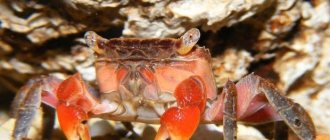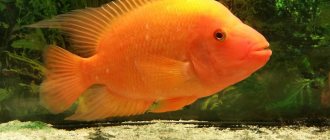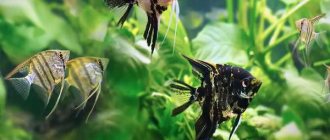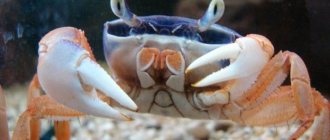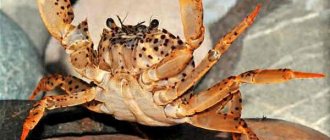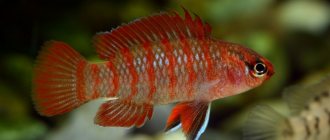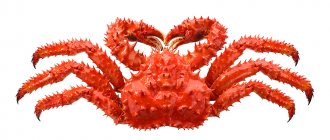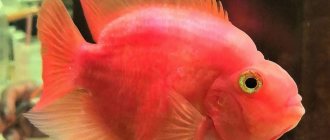The underwater world of a home aquarium is not only about cute fish and snails. Crabs in an aquarium can become interesting pets for many home aquarium lovers. Most of them are representatives of marine fauna, but there are also freshwater ones. They are the ones who become residents of home aquariums.
General information
Geosesarma hagen or in other words Red Devil is a crustacean that will be a worthy addition to your pet’s collection. The lifespan of these crabs varies from two to three years. The Red Devil owes its popularity not only to its name, but also to its bright color coupled with unpretentiousness in content. He is more than friendly towards people. He will be truly devoted to his owners, lift their spirits and amusingly cling to their palms with his paws. Some individuals even eat from their hands.
Externally, the Red Devil is completely no different from other crabs
Important!
This crustacean lives most of the time on land and is primarily terrestrial. This is an important factor when purchasing and furnishing a home.
Adviсe
Some tips that will make caring for crustaceans easier and help create the necessary living conditions:
- Keep your pets alone or in pairs.
- Provide enough sushi.
- Keep the water clean.
- Provide high air humidity.
Before purchasing these arthropods, consider whether you can provide him with optimal care and care. In return, you will receive an exotic and unusual pet that will delight your eyes every day.
(Visited 244 times, 1 visits today)
Appearance
Externally, the Red Devil aquarium crab differs little from typical representatives of the crustacean family. Its size does not exceed four centimeters. Has a shell as protection from enemies. The crab has five pairs of legs in total. The front ones, in the process of evolution, were modified into claws, convenient for holding food and moving it to the mouth with several pairs of jaws.
There are slight differences between the males and females of these individuals. The former, for example, have larger claws, but the abdomen is narrower, while in females, on the contrary, the abdomen is wider. Many are attracted by the colors for which the crab got its name. Body color is quite variable, predominantly dark colors - from purple to black, when the claws are distinguished by bright, red-orange shades. Two yellowish eyes are held on movable stalks and serve as sensory organs.
Reproduction
Preparations for the mating process occur after the winter molt at sea. The female is capable of laying up to several thousand eggs. She spawns eggs on the abdominal limbs, and the male fertilizes them. The incubation process lasts several months. The eggs hatch into tiny larvae that settle on nearby plants until they develop into small crabs. As they grow, they change their shell several times during molting.
Determination of gender
Males and females are distinguished by the shape of their underbelly. In females it is round and large, while in males it is wedge-shaped and elongated, smaller in size. Males are also larger than females in size and limb length.
Shedding
Young representatives quickly grow out of their shell and the molting process occurs. It is regulated by internal enzymes that form a new shell while still inside the old one. During molting, even the walls of the intestines and some internal organs are replaced, and the lining of the eyes is replaced.
The old shell breaks on the sides and on the abdomen, and the crab crawls out of it. This process takes no longer than half an hour. Their new shell is still soft and is not able to protect the animal. Therefore, they hide under stones and driftwood until their shell hardens.
Habitat
You can find the Red Devil in the Solomon Islands, Asia or India. Habitat: exclusively fresh water. In the area where crabs can be found, water from the ocean is mixed with rivers, so the amount of salt in it is much lower. They make their burrows near streams or near marshy areas. So, despite their terrestrial life, they do not lose contact with bodies of water.
Life expectancy at home is 2-3 years
How to keep a vampire crab (Geosesarma vampire) in an aquarium. What to look for when buying
Before purchasing such a pet, it is advisable to read the description of the crab and familiarize yourself with the conditions of its maintenance, and also check with the seller whether the crab was bred in an aquarium or brought from its natural habitat. If possible, choose locally bred individuals; they are more durable and will please their owners longer. With proper care and favorable conditions, they can live in captivity for up to 2-3 years. When buying an imported crab, you should not hope for its long life in captivity, because... he adapts less well to new conditions.
When purchasing, you must also consider the size of the crab. It is advisable to choose small-sized individuals, which indicates that the animal is young, will live longer and will more easily get used to a new habitat. When buying a large, brightly colored specimen, there is a high risk that the crab will already be old.
Care and maintenance
Red devils are considered unpretentious in their care, however, keeping any animal has its own nuances, including breeding crabs.
Rule 1. Spacious aquaterrarium
The fact that the crab usually does not reach even four centimeters does not mean that it needs to be kept in a three-liter jar. The larger the aquarium, the better. It's not that simple with the Red Devils. They spend most of their time on land, so a good option would be to purchase or equip an aquaterrarium with a large bottom area.
Water should occupy a smaller part, and its level should not exceed fifteen centimeters. Crabs can't swim. If you deprive them of sushi, they will simply drown. For an aquaterrarium, you need to purchase a lid, since the arthropods living in them are quite restless and can easily get out into the wild. The search will bring a lot of trouble.
Access to air must be maintained. The solution would be either small holes or replacing the lid with a regular mesh. This is better than setting traps around the house. In the aquaterrarium it is necessary to maintain 100% humidity with periodic spraying.
In an aquaterrarium for a red devil, a significant part of the area should be occupied by land
Rule 2. Suitable water parameters
Those who have just started crab farming have questions about water requirements. When setting up aquariums, this is really important, since the health of the inhabitants directly depends on the environment.
Tap water is rarely suitable for use. It is either filtered completely, or mixed in certain proportions with already purified water. Additionally, they monitor the indicators, which they try to make close to natural ones.
The acidity level, comfortable for marine life, starts from 6.5 and reaches 7.5 pH. If the levels are excessively elevated, crabs have a risk of getting sick.
The overall hardness should not go beyond acceptable limits, because nutrients will become less absorbed. Optimal performance directly affects the Red Devils and plants that are used to decorate the aquaterrarium. Comfortable water temperature for crab is 24-26°C.
Sometimes it is not possible to build a pond inside the terrarium. In this case, special bathing suits are placed in the container. They molt, swim and wet their gills in them. If you have problems with this, a plastic container will do for a while. The main thing is not to forget to settle and change the water several times a week.
The Red Devil Crab spends most of its time on land
Rule 3. Appropriate soil and plants
The goal of any owner remains the proper arrangement of the pet’s home. What about aquaterrariums? Here it is necessary to create a biological balance so that the crabs feel comfortable within the walls of the glass cube.
It is worth paying attention to the soil. It comes in two types: nutritious and neutral. The difference is that the first contains macro and microelements necessary for some plants when there is nothing in neutral soils. In fact, this is ordinary crushed stone. Oddly enough, they recommend the latter. Nutrients have many disadvantages and over time there is a risk of substances being released into the water that are harmful to plants. Even with continued use of fertilizers, they will not feel well.
This will not happen with neutral soils. Need to fertilize? Feed individual plants. When using soils, it is important to monitor the level of carbonate hardness. If it is elevated, the soil is fouled, it is replaced. For plant development, a fraction of 2-3 mm is needed so that there are no stagnant zones and the root system grows correctly. Separately, it is worth mentioning colored primers. It is better to avoid them altogether, as the paint will peel off over time and the appearance will deteriorate significantly.
Red devils do not touch plants, but young tender shoots can cause damage.
Cryptocoryne nuri
Hydrocotyl verticillate
Pistia
Below is a list of what can be planted in a crab aquaterrarium:
- Cryptocoryne nuri is a beautiful plant that can survive in almost all conditions. The aquarium plant Cryptocoryne is compact, tight-knit and will decorate any aquarium.
- Hydrocotyl verticillata, as well as hydrocotyl tripartite, or in common parlance, water navel, is quite unpretentious. It has this name because it grows with umbrellas. If it takes root, it can grow all over the bottom, resembling a clearing dotted with green mushrooms. The size of such umbrellas varies and depends on the lighting - the brighter the light, the tighter the plant.
- Pistia at first glance resembles a head of cabbage. By the density of its roots you can determine how often you need to change the water in the aquarium. The red devil eats its leaves.
- Marsilia. Of the minuses: it grows slowly, and you can turn gray while waiting for a fluffy carpet, but it will serve as a good accent.
- Staurogin brown brown. Unlike the previous representative, it grows wildly and does not cause problems in maintenance. It looks very nice from the outside.
- Moss. It will serve as an unusual decor and help bring daring ideas to life. Quite unpretentious. Since moss is bitter, no one usually touches it, but the Red Devil is an exception. He won’t eat it, but he’ll take it apart piece by piece with his claws.
- Salzman's Hediotis. In order for the plant to not look like just a pod, intense lighting will be required. Then it will press against the ground and form lush underwater thickets.
Marsilia
Staurogyne brown
Moss
Hediotis salzman
Rule 4. Equipping the home with burrows
The design and filling of the aquaterrarium depends on the owner. As an addition to the aquarium, you can use pebbles or driftwood. Crabs cannot live without holes, which should be taken care of in advance. You can drill holes in the snags or, as a last resort, install pipes into which your pet can climb if necessary.
Important!
Lamps, purifiers and other devices cannot be installed in the aquaterrarium itself. You can easily snack on them, which will lead to an electric shock.
Additional decor can include:
- Sand. Combines well with soil. Crustaceans love to sit in burrows that they have made themselves. At first, they are uncomfortable around humans and other aquarium inhabitants, so the sand will serve as a saving anchor.
- Stones. Sellers provide options for every taste and color. They should not be too sharp: the crab is not in danger, but the fish swimming around the perimeter may get hurt. Visually, it is better to place large objects on the sides, closer to the glass.
- There is no need to buy driftwood at all. It is not difficult to build them at home. You will need an ordinary twig, cleared of dirt and bark. The finished decoration is placed inside the aquaterrarium. For the Red Devils, they will also become a reliable shelter in case of danger.
- Shells, corals. Exotic fans fill the bottom with real shells. You need to know in advance that such natural decorations affect acidity and change the hardness of water. Sometimes this is fraught with illnesses for pets. You can choose harmonious artificial reefs.
- If the aquarium is located against the wall, you can attach a background. There are two types: external and internal. One is glued inside and looks believable, the second can increase the space and is simpler in terms of execution.
- Other decorations. Who wasn’t attracted to beautiful chests and original figurines? Some of them are made to order at the discretion of the buyer. The advantage is that they do not have harmful impurities and do not affect water and air parameters in any way. That is, they are absolutely safe for both crabs and other animals.
Description
Crabs, or short-tailed crayfish in other words, are a detachment from the subtype Crustaceans, included in the class Higher Crayfish. The remains have been discovered in fossils dating back to the Jurassic period. Now they have hardly changed their appearance and still look like their ancestors. These arthropods are located almost all over the globe.
Crabs are close relatives of crayfish. Their difference is in the external absence of the abdomen, which ends in the tail. They have an abdomen, but it is too small and is located under the chest. The tail would interfere with movement on land.
In these crustaceans, the body size depends on the specific species and ranges from 4 to 35 cm. A distinctive feature from other animals is the presence of strong claws, which are designed for hunting, protecting and cleansing the body. Another 4 pairs of limbs help arthropods move. Small, underdeveloped 2 limbs near the mouth opening help absorb food.
They live in rivers, seas, oceans, rarely on land. They are able to swim in the water column and crawl along the bottom.
The shell color of most species is brown-green. But the body color of different species adapts to their environment. The inhabitants of the sandy bottom are golden beige in color, while those who like to hide in algae are light green. Representatives from coral reefs are colorful.
Arthropods are becoming increasingly common aquarium pets. But they are not very friendly to other underwater inhabitants, even to members of their own family. It is better to keep them alone.
How long do they live?
The lifespan of crabs ranges from 3 to 6 years.
Feeding
There will be no problems with nutrition; crabs eat almost everything. To a greater extent, of course, plant foods: vegetables, fruits, meat, lean fish, shrimp. It is better to first scald everything that crabs eat with boiling water.
You can buy special food in tablets, the cans of which say “for all types of fish and crustaceans.” They include almost everything you need: vegetable protein extract, grains, shellfish, algae, minerals, oils, fats and vitamins. However, in terms of price, they are far from the most budget option. These arthropods eat insects. For example, the aphid population will be exterminated instantly.
The red devil should not be overfed. Many people talk about this, but do not name the reason. In fact, everything is simple: in nature, with good nutrition, crabs prepare for molting and shed their shell, which constrains the body. The crab grows with a fragile shell. If an individual is overfed, it will not be possible to throw it off, which will lead to suffocation and death.
Diet
Crabs need to be fed both animal and plant foods.
They willingly eat:
- pieces of fruit: melon, banana, peach;
- leafy vegetables;
- zucchini, cucumbers;
- raspberries;
- seaweed;
- leaves of aquatic plants.
The following are used as animal feed:
- pieces of krill and squid;
- sea fish;
- mussels;
- pieces of boiled chicken;
- bloodworm, coretra, tubifex.
You can feed granular or tableted commercial food for crustaceans.
Professionals provide food rich in calcium so that the external skeleton is strong. The best option would be grasshoppers. They contain, in addition to a large amount of protein, chitin, which is necessary for building the shell of crustaceans.
It is recommended to give food at least 1 time per day; it is better to divide the volume into 2-3 portions and give it in parts so as not to pollute the water with uneaten leftovers. If only crabs live in the aquaterrarium, it is better to place pieces of food on land.
Equipment
A lot of equipment will be required for an aquaterrarium. You can, of course, do without extra costs, but you can’t put inhabitants in an ordinary bank either. Crabs are not overly whimsical, however, they should not be left without the benefits of civilization.
- A filter is required as it purifies the water and saturates it with oxygen. The choice of model directly depends on the size of the aquarium: external ones are used for large volumes, internal ones are used for small-sized options. Some filters replace compressors, which are gradually fading into the background.
- Lighting. Not the last part for the development of plants and the life of the inhabitants of the glass cube. Some aquariums are sold with a lid and attached bulbs or lamps. Some people buy it separately. Bright light and bulbs with a spectrum range that goes into red or blue are comfortable for the inhabitants.
- The temperature inside the aquarium should not fall below 25°C, but when the room is cold, a heater will come to the rescue. They sell regular ones - the inconvenience is that you have to observe the changes yourself - and with a thermostat, which are suitable for maintaining the microclimate.
- A thermometer is a must-have item for monitoring water temperature.
The Red Devil Crab is an omnivore
Compatibility
Red Devil doesn't live up to its name. He is friendly and gets along without problems with other inhabitants of the tank. He does not show excessive aggression even towards his fellow tribesmen. These crabs can be kept in groups. Fights occur from time to time, but not to the point of death. Out of habit, they spend most of their time in minks. When feeding, it is enough to scatter food in different parts of the aquaterrarium, then there will be no collisions at all.
Do not touch the shrimp. However, if circumstances require it, they can become hunters. Sometimes they try to grab fish swimming nearby. There are videos online where snails are added to arthropods, to which they show no interest. This doesn't always happen. Sometimes the Red Devil pulls out melanias buried in the ground, picks them out of their shells and, getting out onto land, eats them.
Where to buy and prices
Red Devils are in demand on the market. The easiest way is to buy an individual in an online store. Delivery is carried out both to your home by couriers and to pick-up points. It is possible to see and purchase this type of crab in pet stores. Prices are not high, rarely exceeding 500 rubles. On average, the Red Devil will cost 350 rubles.
This type of crab is very peaceful towards other aquarium inhabitants.
Red devils are easy to keep and friendly by nature. By keeping these in an aquaterrarium, you can enjoy watching the adults every day. At first, small crabs are afraid to be seen, but over time they get used to it, crawling out of their holes in anticipation of goodies.
Would you like to purchase such a crab for your own aquaterrarium? Share in the comments!
